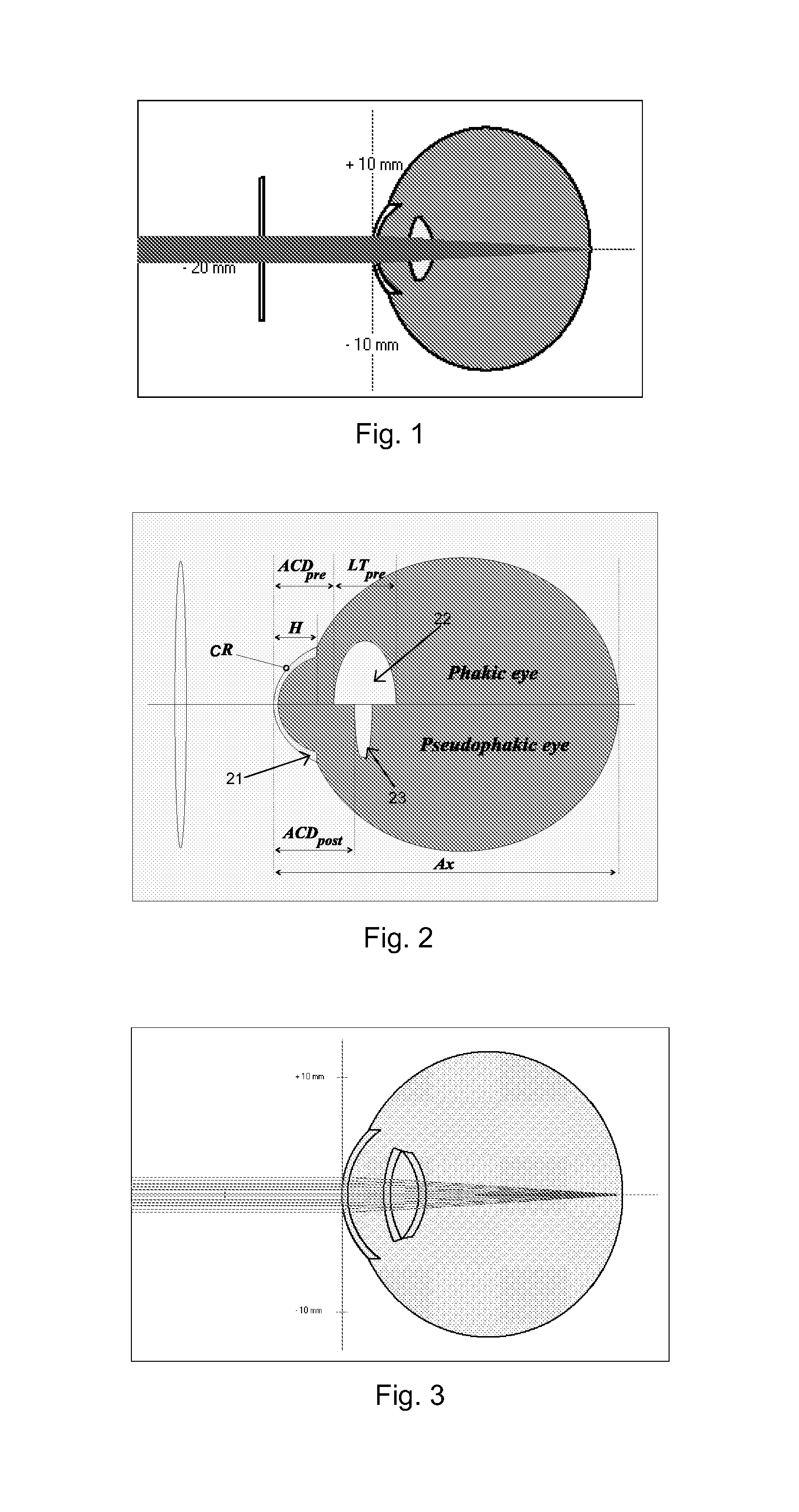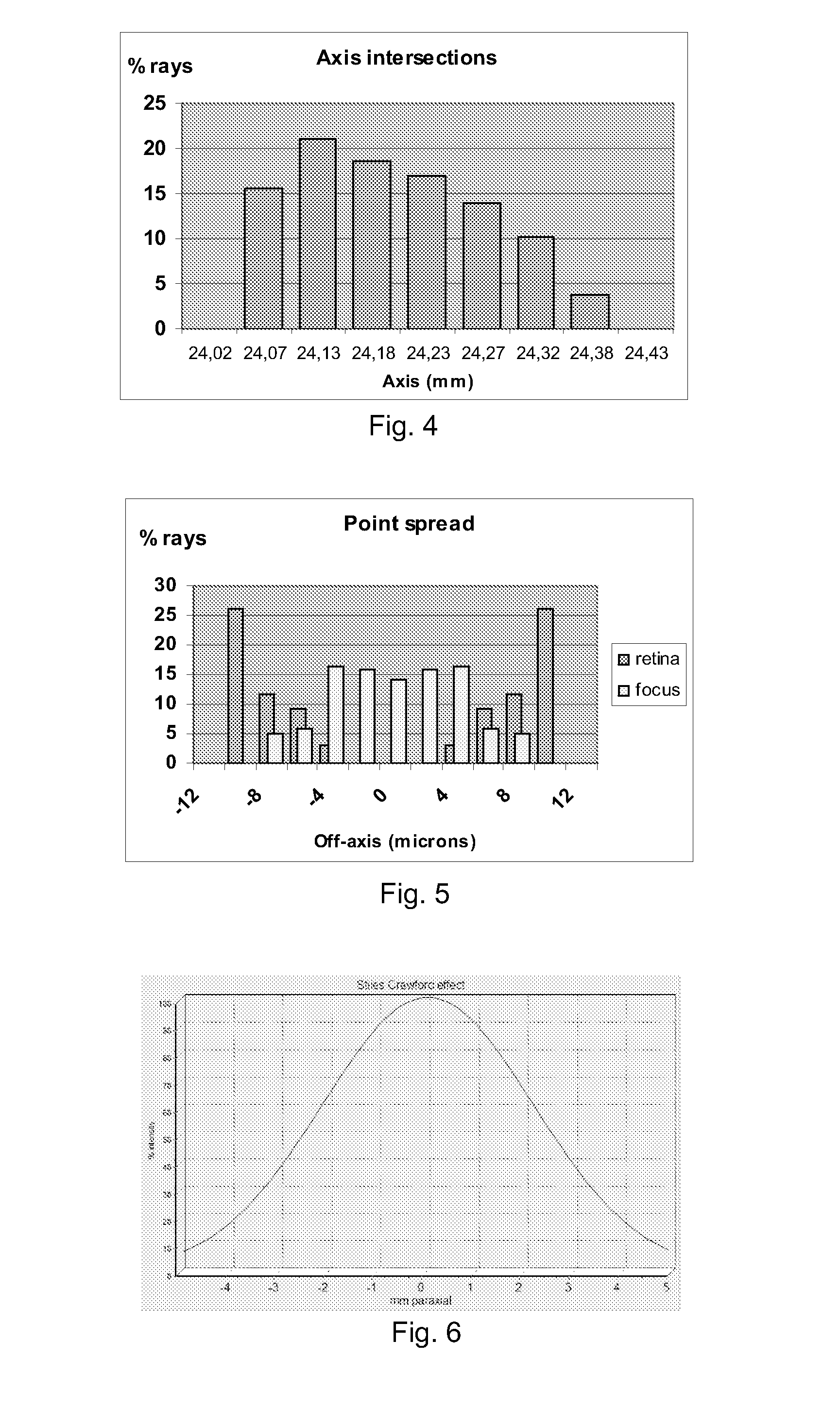System and Method for Determining and Predicting IOL Power in Situ
a technology of iol power and system, applied in the field of system and method for determining and predicting iol power in situ, can solve problems such as difficult to perform, and achieve the effect of preventing, treating and/or ameliorating diseases
- Summary
- Abstract
- Description
- Claims
- Application Information
AI Technical Summary
Benefits of technology
Problems solved by technology
Method used
Image
Examples
example 1
Ray Tracing Analysis of Gullstrand Eye
[0200]The exact schematic eye of Gullstrand (Gullstrand, 1909, Gullstrand, 1924) was used as an example of the ray tracing analysis. For many years the exact schematic eye of Gullstrand has been used to simulate the optical properties of the human eye. Apart from the object plane and the image plane the structure of the schematic eye is a 6 surface model as shown in Table 1:
TABLE 1Surfaces of the exact schematic eye of Gullstrand.SurfaceNamex-PositionRadiusConicindex0Object−3010000011Cornea front07.701.382Cornea back0.56.801.343Lens front3.61001.394Nucleus front4.157.9101.415Nucleus back6.57−5.7601.396Lens back7.2−601.347Retina (image)24−1300Each surface is given number from left to right, a name, an axis location (x-Position), a radius of curvature (positive means anterior convex and negative means anterior concave), a conic coefficient (zero for this eye model) and a refractive index.
[0201]In the Gullstrand eye the axial length of the eye is a...
example 2
Ray Tracing Analysis of Eye with IOL Implant
[0206]Further ray tracing examples show an eye of average dimension with a spherical IOL implanted to give good uncorrected vision at a negligible pupil size. The effective refraction has been plotted against the diameter of the pupil with and without correction for the Stiles-Crawford effect. FIG. 7 illustrates the effect of pupil size on the refraction predicted for a normal eye of average dimension with a spherical IOL implant. As the pupil widens, the eye becomes myopic as a result of spherical aberration. The effect is compensated for by the Stiles-Crawford effect (‘SC’). Two observations can be drawn from FIG. 7:[0207]1) The effective refraction is dependent on the pupil size also within the normal range (less than 3-4 mm), and[0208]2) The Stiles-Crawford effect compensates for the spherical aberration at larger pupil sizes.
example 3
Determination of IOL Power Actually Implanted (‘in situ’)
[0209]The refractive outcome (spectacle correction) of 53 eyes with an IOL implant with good postoperative visual acuity (>20 / 40) was evaluated. The cases were selected to cover a large range of IOL powers but otherwise randomly chosen from the consecutive series of lens surgeries performed at the Cataract Clinic, University of Aarhus, Denmark. The IOL implanted was an IOL of spherical design (Alcon SA60AT Acrysof) with a labelled power ranging from +2.0 to +40.0 D.
[0210]IOL Data
[0211]The assumed physical characteristics of the IOL (thickness, refractive index, front and back curvature were obtained from the ‘cutting chart’ provided by Alcon). The example of the cutting chart is given in the table 2.
TABLE 2‘Cutting’ chart provided from Alcon Laboratories showing the radii ofthe anterior and posterior surface of the IOL according to power.SA60AT & SN60ATDiopter RangeAnterior RadiiPosterior Radii 6.0-9.5 D35-81mm75.0 mm10.0-15.5...
PUM
 Login to View More
Login to View More Abstract
Description
Claims
Application Information
 Login to View More
Login to View More - R&D
- Intellectual Property
- Life Sciences
- Materials
- Tech Scout
- Unparalleled Data Quality
- Higher Quality Content
- 60% Fewer Hallucinations
Browse by: Latest US Patents, China's latest patents, Technical Efficacy Thesaurus, Application Domain, Technology Topic, Popular Technical Reports.
© 2025 PatSnap. All rights reserved.Legal|Privacy policy|Modern Slavery Act Transparency Statement|Sitemap|About US| Contact US: help@patsnap.com



